Asus ROG Zephyrus G15 review (GA503RW model, AMD Ryzen with RTX)
This is our detailed review of the Asus ROG Zephyrus G15 in the higher-specced 2022 edition, built on an AMD Ryzen 9 6900HS processor and Nvidia RTX 3070Ti graphics.
The 2022 Zephyrus G15 is at a first glance mostly an incremental update of the previous generation from 2021, built on the same chassis and design, but with slight functional updates such as the addition of a much-needed camera at the top of the screen, an RGB keyboard on all color options, and faster connectivity.
However, what makes this especially interesting at the time of this review, mid-August 2022, is the fact that this is one of the most affordable RTX 3070Ti portable laptops available on the market now.
On top of that, the GPU in this 2022 model runs at higher power than on the past generations, and all the other specs have been updated to this year’s level, which means you’re getting a Ryzen 9 6900HS processor, a MUX switch, DDR5 RAM, and an option for faster PCIe gen4 storage. All for around 2K USD/EUR for the 3070Ti model, or less for the 3060 variant.
Thus, while the ROG Zephyrus G15 is not the most powerful or the fanciest of portable laptop designs at this point, it is for sure one of the best-value offers you can find in stores now, which matters greatly in today’s economic environment. Hence, I expect many of you to have this on your shortlist in the coming months.
Specs sheet- Asus ROG Zephyrus G15
2022 ASUS ROG Zephyrus G15 GA503RW
Display
15.6-inch, 16:9, non-touch, matte, BOE BOE0A55 panel
QHD 2560 x 1440 px IPS, 165 Hz 3ms with 100% DCI-P3 colors, 350-nits brightness
Processor
AMD Rembrandt, Ryzen 9 6900HS, 8C/16T
Video
AMD Radeon + Nvidia GeForce RTX 3070Ti Laptop 8GB (80W, up to 120W with Dyn Boost) on 503RW model,
with MUX and AdaptiveSync
Memory
32 GB DDR5-4800 (16 GB on board, 1x DIMM, up to 48 GB)
Storage
1 TB NVMe SSD (WD PC SN735) – 2x M.2 PCIe gen4 slots
Connectivity
WiFi 6E (Mediatek MT7922) 2×2 with Bluetooth 5.2, 2.5 Gb Gigabit LAN (Realtek RTL8168/8111)
Ports
2x USB-A 3.2 gen2, 2x USB-C gen2 with video, data, and charging, HDMI 2.0b, microSD card reader, LAN, headphone&mic
Battery
90Wh, 240 W power adapter + USB-C charging up to 100W
Size
355 mm or 13.98” (w) x 243 mm or 9.57″ (d) x 19.9 mm or .78” (h)
Weight
2.02 kg (4.45 lbs), .74 kg (1.63 lbs) power brick and cables, EU version
Extras
RGB backlit keyboard, 6x speakers, HD webcam with IR Hello, available in White or Gray
Aside from this model here, the 2022 Zephyrus G15 GA503 is also available in a Ryzen 9, RTX 3060, 16 GB RAM, 512 GB SSD configuration, for around $1600 USD / 1500 EUR. That’s also very competitive and something to consider if the gaming performance isn’t crucial for you.
Design and construction
Just like in the past, the 2022 Zephyrus G15 is available in two color variants, a white model with a white keyboard, and a dark-gray model with black keys. Our review unit is the white model, but the dark-grey variant is the most widespread.
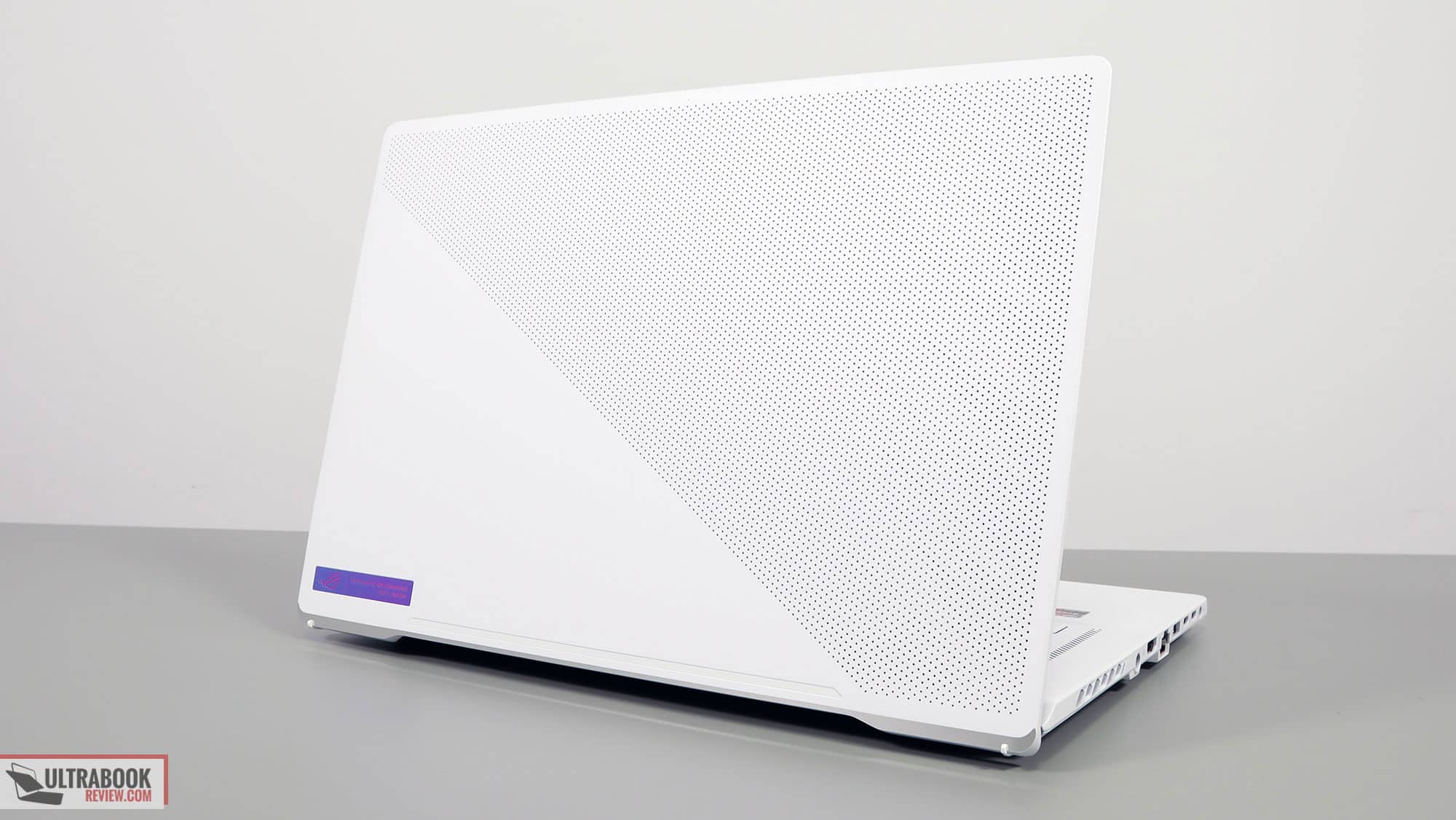
Now, as far as the design and ergonomics of this 2022 update go, almost nothing has changed from the previous generation, so I’ll refer you to my previous article for my in-depth thoughts on how this series looks and feels with daily use.
Briefly, the Zephyrus G15 is a lightweight and portable laptop with a full-size 15-inch display. It weighs just around 2 kilos, and thus makes perfect sense if you’re after something that you plan to carry to school/work every day.
The build quality is fine, with a sturdy main chassis and only some flex in the lid. It’s not the sturdiest, but it’s not bad either. I haven’t noticed any squeaky noises in the main body, unlike in the past, so Asus seems to have slightly reinforced the construction for this model year. For the materials, the main chassis is made out of magnesium alloys, while the top is a white-coated aluminum.
That aside, the main advantage of this white color variant is the fact that it doesn’t show dirt or fingerprint easily. It also attracts a fair bit of attention, as few such other laptops come in all-white. On the other hand, the contrast of the white-lit keys isn’t as good as with the black keys on the other color version, and the black bottom bezel under the screen stand-out in a rather ugly way with everything else being white. In an age where many other laptops offer 16:10 panels with a smaller chin, this might be something that will deter you from this series.
A novelty for the series is the addition of a webcam at the top of the display, flanked by microphones. It’s not much in quality, but at least it’s there for your calls.
Otherwise, this Zephyrus G15 is still an Ergolift hinge design, with the mais body designed to lift up on the small feet placed at the bottom of the screen, in order to improve the airflow underneath. That means the exhausts are still placed under the display, and the hot air blows into the panel, but this aspect is not that much of an issue here, as that heffy plastic chin soaks up most of the heat and the panel doesn’t heat up the same way as on the Zephyrus G14 or M16.
As far as other practical aspect go, I appreciate the friendly edges and corners, the good grip on the desk, and the fact that the screen goes back flat to 180 degrees if needed.
On the other hand, I’m not a fan of the big status LEDs placed under the display, and the IO placement still isn’t great, with most ports squeezed on the left edge, towards the front of the laptop. Hence, expect a cluttered experience if you plan to hook up multiple peripherals.
You are getting a fair selection of ports, at least. There’s no HDMI 2.1, but one of the USB-C ports hooks into the dGPU, if you plan to output games on an external monitor.
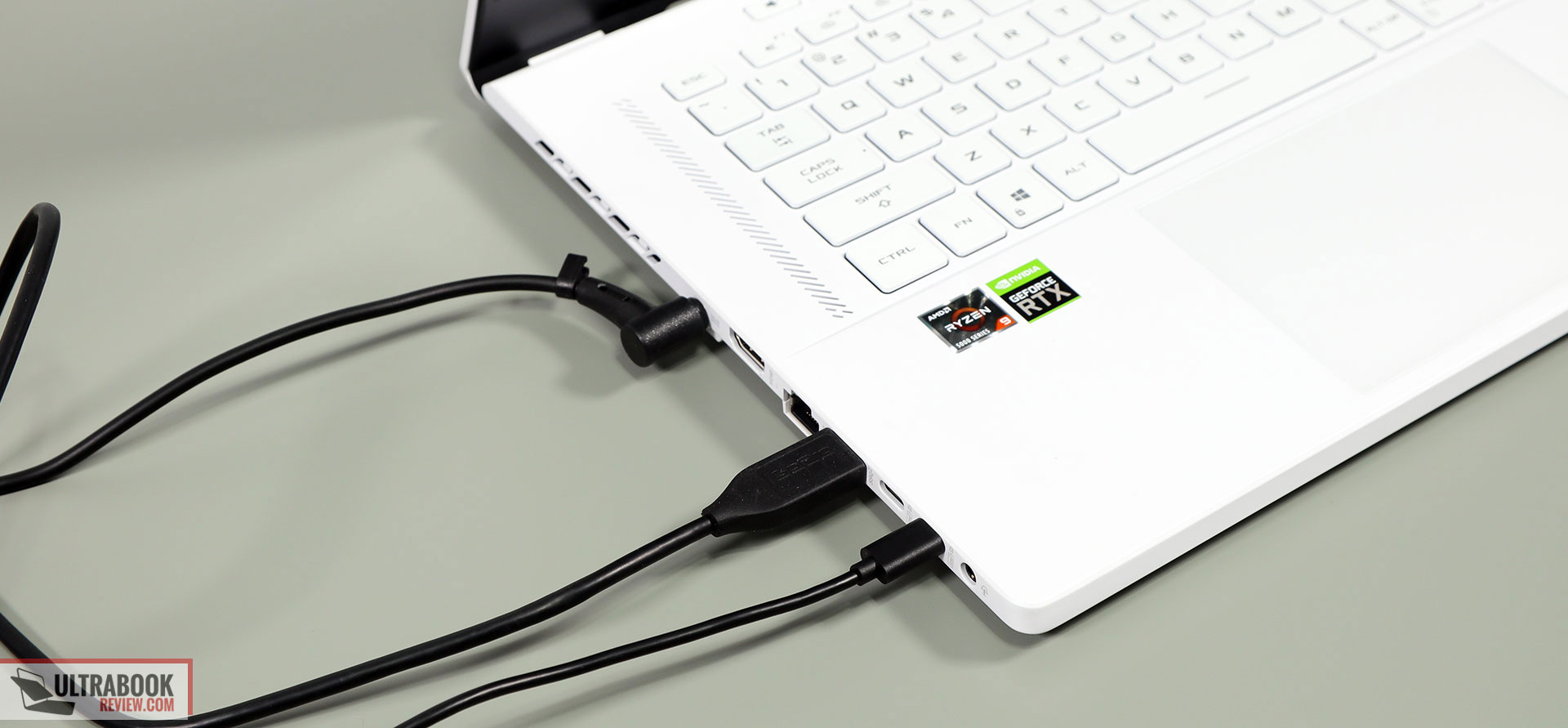
All in all, the 2022 Zephyrus G15 is pretty much the same design as before, it just feels a little better built as the main chassis no longer squeaks and creaks with daily use. Plus, there’s now a camera at the top of the screen.
Keyboard and trackpad
The inputs haven’t changed from the 2021 Zephyrus G15, with the exception that all variants now ship with an RGB-lit keyboard.
The keyboard’s layout is standard for an Asus laptop, nothing weird about it, except for perhaps the fact that there’s no dedicated Print-screen key, which some of you might need. It’s a simplified centered layout, though, without a NumPad section or any extra columns of Function keys at the right. That’s because the space around the keyboard is reserved for the speaker grills.
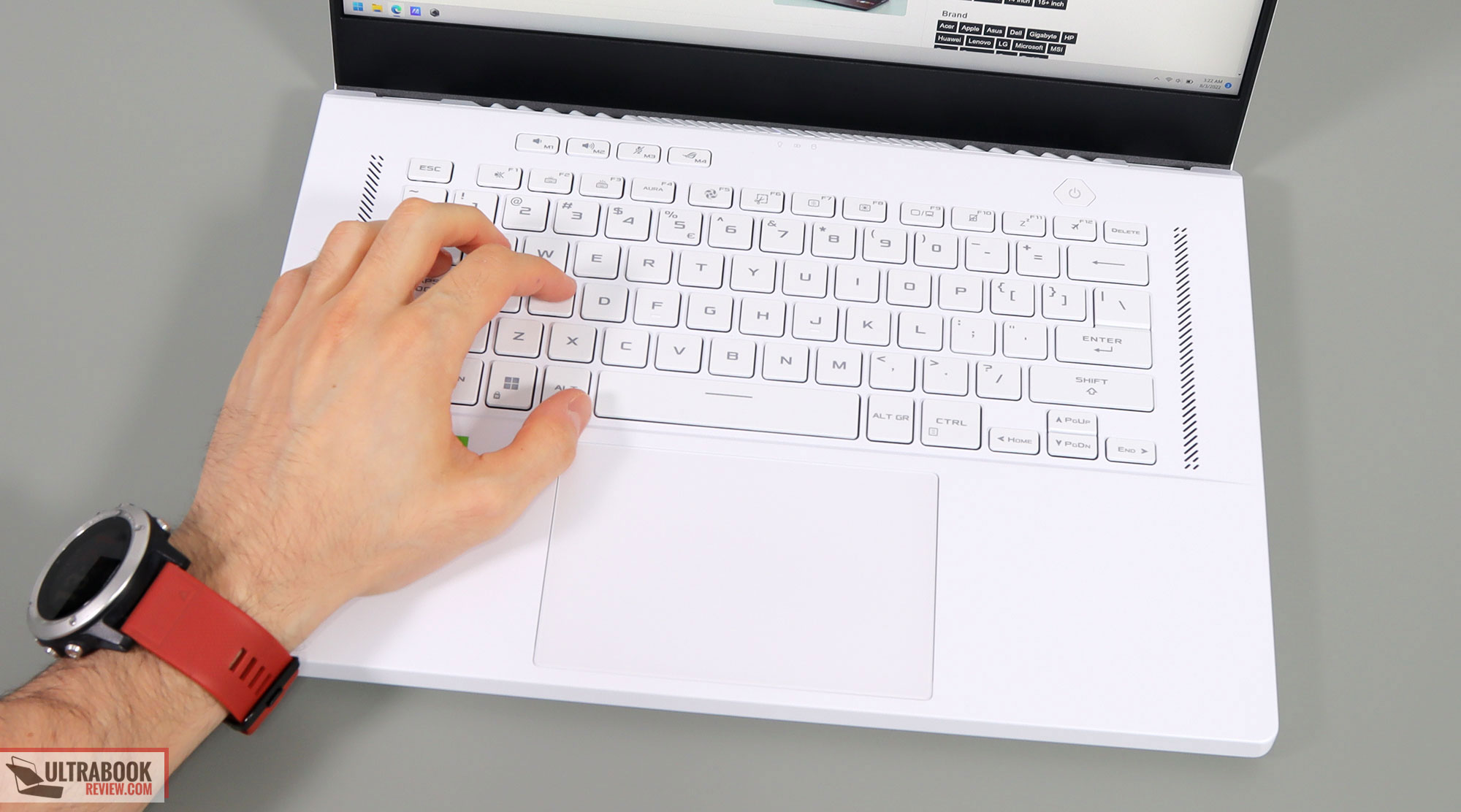
Having typed thousands of words on this keyboard, I feel this is a very good typer and one I can see myself using every day. I like the feedback, the click, the travel depth, and how the smooth plastic keycaps feel to the touch. They do type a bit noisier than other implementations, but I doubt will attract any attention even in quiet environments.
The white version of this laptop gets white keys with RGB illumination now, unlike the white-only implementation of the past. It’s single-zone, but still this means you can opt for a color that improves the contrast against eh white keycaps, such as some sort of Orange or Blue.
The LEDs get bright and they’re fairly uniform in this model year, which once more is an update from the past G15s. Some of the light still creeps out from under the keycaps, but not in a very noticeable way.
The clickpad is still pretty much flawless and one of the better I’ve tested on any Windows laptop lately. Asus went with a wide surface made out of smooth glass, which feels accurate and reliable with swipes, gestures, and taps. Plam rejection is spot-on as well, and this doesn’t rattle with taps, unlike other large clickpads. The physical clicks are quiet and smooth. Well done!
For the biometrics, there’s no longer a finger-sensor in the power button on this 2022 Zephyrus G15, but you do get IR Hello support baked into the camera.
Screen
There’s only one screen option available for the 2022 Zephyrus G15 series, a QHD 16:9 matte panel with 240Hz refresh and 100% DCI-P3 color coverage. This is the same panel that Asus offer on the 2022 ROG Scar 15 series.
This is a slight step up from the 165Hz panel offered on past models, with a higher refresh and faster response times. Paired with the included MUX and higher-power dGPU, this model-year G15 is now a more competent gamer than before.
For everyday use, though, this panel feels much like the previous one, with good colors and viewing angles, fair blacks and contrast, and only average maximum brightness at sub-350 nits. That’s OK for indoor use, but not really enough for bright spaces or outdoor use, something you should consider in your research.
Here’s what we got in our tests of this QHD panel, with an X-Rite i1 Display Pro sensor:
- Panel HardwareID: BOE BOE0A55 (NE156QHM-NZ2);
- Coverage: 99.8% sRGB, 84.7% AdobeRGB, 99.1% DCI-P3;
- Measured gamma: 2.21;
- Max brightness in the middle of the screen: 332.18 cd/m2 on power;
- Min brightness in the middle of the screen: 15.22 cd/m2 on power;
- Contrast at max brightness: 1094:1;
- White point: 6800 K;
- Black on max brightness: 0.30 cd/m2;
- PWM: No.
- Response: 4 ms GTG (via NBC).
The panel comes well calibrated out of the box, with just a slightly skewed White Point. It also proved to be uniform in our tests, and didn’t show any noticeable light-bleeding around the edges.
All in all, this is an excellent multi-purpose display, as long as your plan to keep your laptop indoors.
At the same time, you will find larger 16:10 and brighter panels on something like the Zephyrus M16 or the ROG Flow X16, and I can see why some of you might want to go with those sorts of screens instead of what’s available for the G15 series. Here’s a side by side picture of the G15, M16, and Flow X16, just for comparison.

Hardware and performance
Our review model is a higher-specced configuration of the ASUS ROG Flow X16, code name GV601RM, built on an AMD Ryzen 9 6900HS processor, 32 GB of DDR5-4800 memory in dual channel, 1 TB of fast SSD storage, and dual graphics: the Nvidia RTX 3060 dGPU with 6 GB of vRAM and the Radeon 680M iGPU integrated within the AMD processor.
Disclaimer: Before we proceed, keep in mind that our review unit is a retail unit and runs on the matture software available as of mid-Aug 2022 (BIOS 308, Armoury Crate 5.1.12, GeForce 512.78 drivers). This is a mature software package, as we are testing this laptop several months after it was launched, so expect little to change with later BIOS/software updates.
Spec-wise, the 2022 ASUS ROG Flow X16 series is built on the latest AMD Ryzen HS and Nvidia RTX hardware available to date. The Ryzen 9 6900HS is an AMD Rembrandt 6000 processor, with 8 Cores and 16 Threads. It’s the more efficient bin of the standard Ryzen 9 6900HX found on full-size laptops, with almost the same capabilities as long as provided with enough power. It’s also a revision of the Ryzen 9 5900HS from last year, built on the updated Zen3+ 6 nm technology, with improvements in design, IPC, and efficiency.
The thermal/power design of this Zephyrus G15 allows the processor to run at up to 70W of sustained power in demanding CPU loads, which is lower than other designs. Regardless, the CPU runs at almost the best of its abilities in this laptop, but at high temperatures under sustained load. We’ll discuss it further down below.
For the GPU, this series is available with RTX 3060 and 3070Ti graphics chips. What we have on this sample is the higher-tier RTX 3070Ti running at up to 120W in supported games and applications, with Dynamic Boost. that’s a step-up from the 100W TGP of the past Zepyrus G15 models.
For the RAM, the laptop comes with partially soldered memory and one accessible DIMM. Our unit gets 16 GB onboard memory, but I upgraded it to 32 GB to document the differences you should expect when having both RAM modules populated.
For storage, the two M.2 2280 slots are PCIe gen4 capable, but our unit only shipped with a PCIe gen3 WD NS735 SSD. This will vary between regions, though, and your unit might come with a faster PCIe gen4 SSD by default. Otherwise, you do get the option to upgrade the SSD if you want to, in case you might need something faster.
Getting inside to the components is fairly easy, you just have to pop up the back panel, hold in place with a couple of Philips screws. Careful they’re of different sizes, and the three of them in the middle of the laptop are hidden behind rubber caps. Inside you’ll find the SSDs and RAM slot, the Wi-Fi model, the thermal module, and everything else.
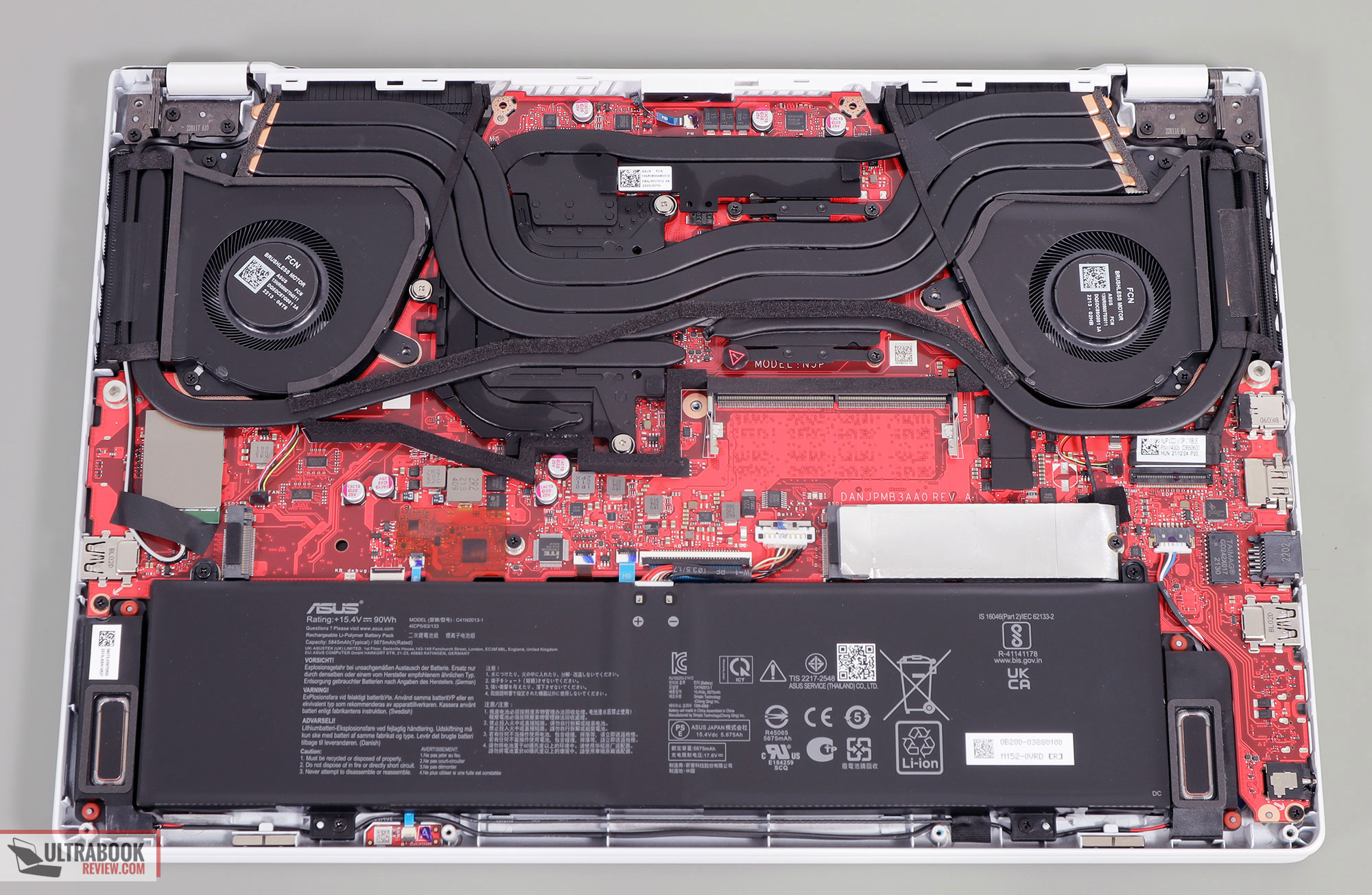
Specs aside, Asus offer the standard four power profiles in the Armoury Crate control app for this laptop: Silent, Performance, Turbo, and Manual, with various power settings and fan profiles between them.
Operating Mode
Silent
Performance
Turbo
Manual
CPU sustained TDP
45W
~50W
<70W
<70W
GPU sustained TGP
~55W (Whisper M, 60 fps)
80W + 20W DBoost
100W + 20W DBoost
100W + 25W DBoost
TDP + TGP sustained (Crossload)
~70W
~125W
~140W
~140W
Noise at head level
sub 35 dbA
max 45 dbA
max 52 dbA
max 53 dbA
Turbo is only available with the laptop plugged into the wall and is meant for gaming and other demanding loads. Performance is a jack-of-all-trades, while Silent is made for light daily use. The system is able to idle the fans on the Silent profile as long as the CPU/GPU stay under 60 degrees C, leading to a mostly noiseless daily-use experience.
Performance and benchmarks
On to more demanding loads, we start by testing the CPU’s performance by running the Cinebench R15 test for 15+ times in a loop, with a 1-2 seconds delay between each run.
First off, with the laptop sitting on the desk, the Ryzen 9 processor stabilizes at ~67-68W of sustained power on the Turbo setting, which translates in frequencies of ~4.1-4.2 GHz, temperatures of ~95 C, and scores of ~2250 points. The fans spin at ~52dB at head-level in this mode, in this test. The CPU runs hot and minimally thermally throttles, but overall performs at nearly its maximum capabilities, as you’ll see in a bit.
Bumping the laptop off the desk in order to improve the airflow of cool air into the fans doesn’t change anything in this test. Nor does switching over to the Manual mode with max fans, as the fans are already running at their maximum rpms on the Turbo profile. Hence, there’s no easy way to improve the sustained performance or thermals of this design.
Switching over to the Performance/Balanced profile translates in the fans spinning much slower and quieter, at ~35 dB in this test. As a result, the CPU still runs hot and thermal throttles around 50W CPU stabilizing at just around 50W, and the scores drop to around 2000 points.
Then there’s also the Silent profile, which limits the sustained power at ~45W, with the fans running at sub 30 dB, and temperatures in the low-90s C. The Ryzen 9 still scores just shy of 2000+ points on this profile, roughly 85% of the Turbo/Manual performance, which is definitely impressive for a Silent profile and showcases the AMD platform’s efficiency and capabilities at mid-power settings.
Finally, the CPU runs at ~35 W on battery, on the Performance profile, with stabilized scores of around 1900 points and fans at sub-35 dB. Details below.
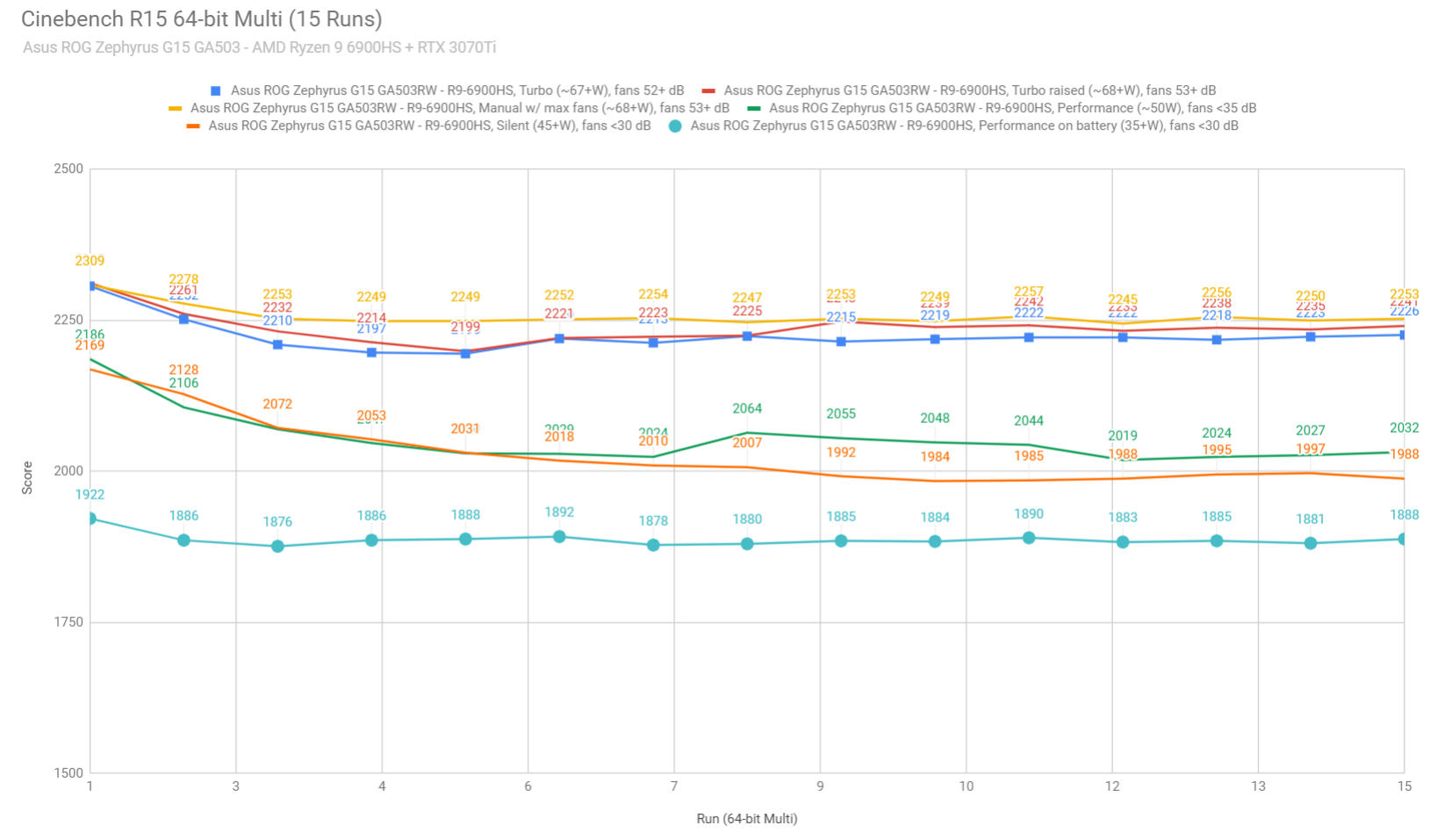
To put these in perspective, here’s how this Ryzen 9 6900HS implementation fares against other mobile platforms in this test, both Intel and AMD.
The Ryzen 9 6900HS platform can run 2-3% faster in designs with better cooling and power limits. However, those other designs allow for much quieter fan noise in comparison to this G15, which is their main advantage over the G15.
At the same time, the 2022 6900HS ends up about 5% faster than the 5900HS in the previous-generation Zephyrus G15.
On the other hand, the 2022 Intel platforms can outmatch the R9 by as much as 20% in higher power designs such as the ROG Zephyrus M16. However, at power levels around 60-70W, the two platforms end up roughly equal in capabilities, which once more shows the efficiency advantage of the AMD platform. At 50W or less – equivalent to the mid-level and quieter profiles on these portable laptops, the AMD platform outscores the Intel hardware.
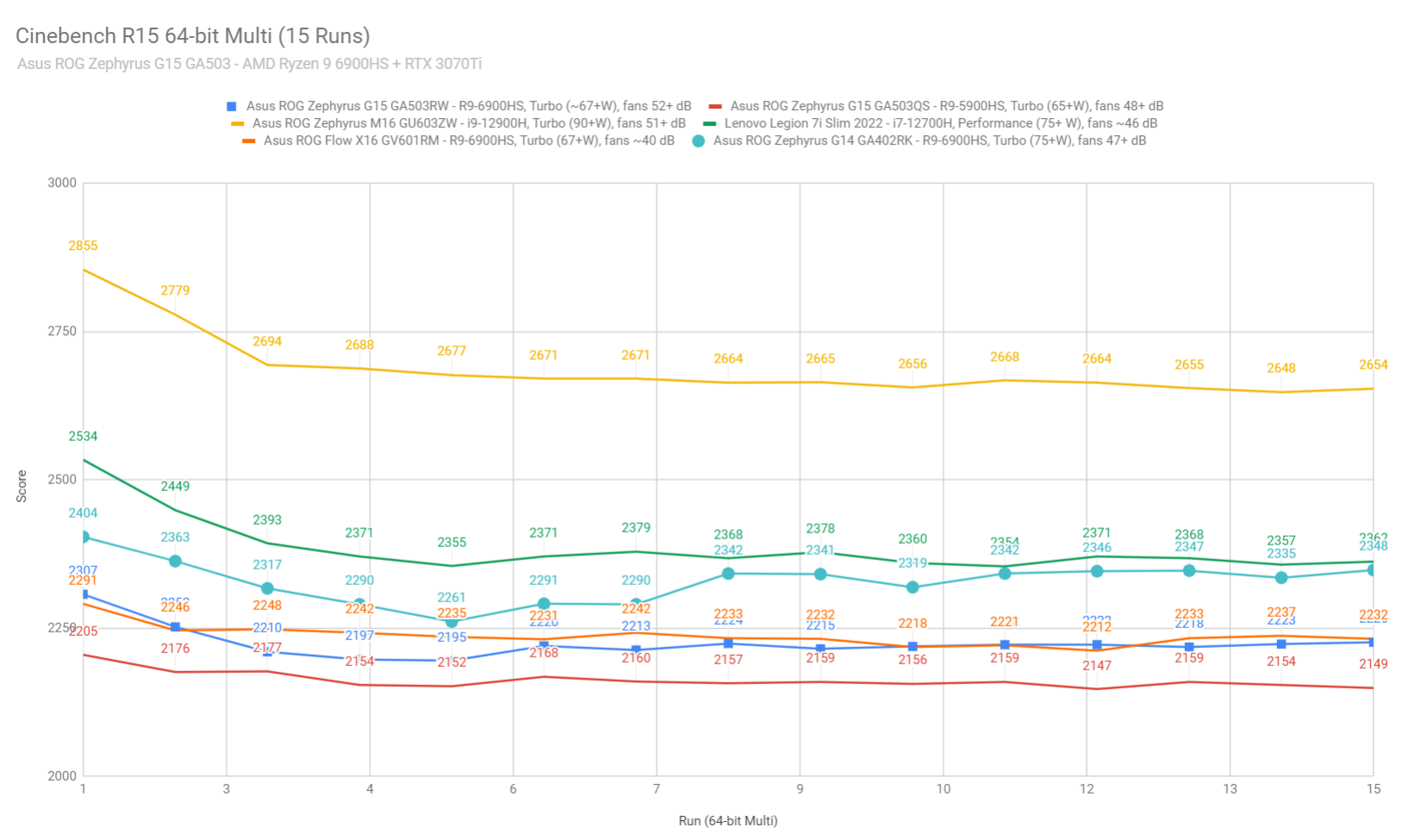
We then went ahead and further verified our findings with the more taxing Cinebench R23 loop test and Blender – Classroom, which resulted in similar findings to what we explained above.
We also ran the 3DMark CPU test on the Turbo profile.
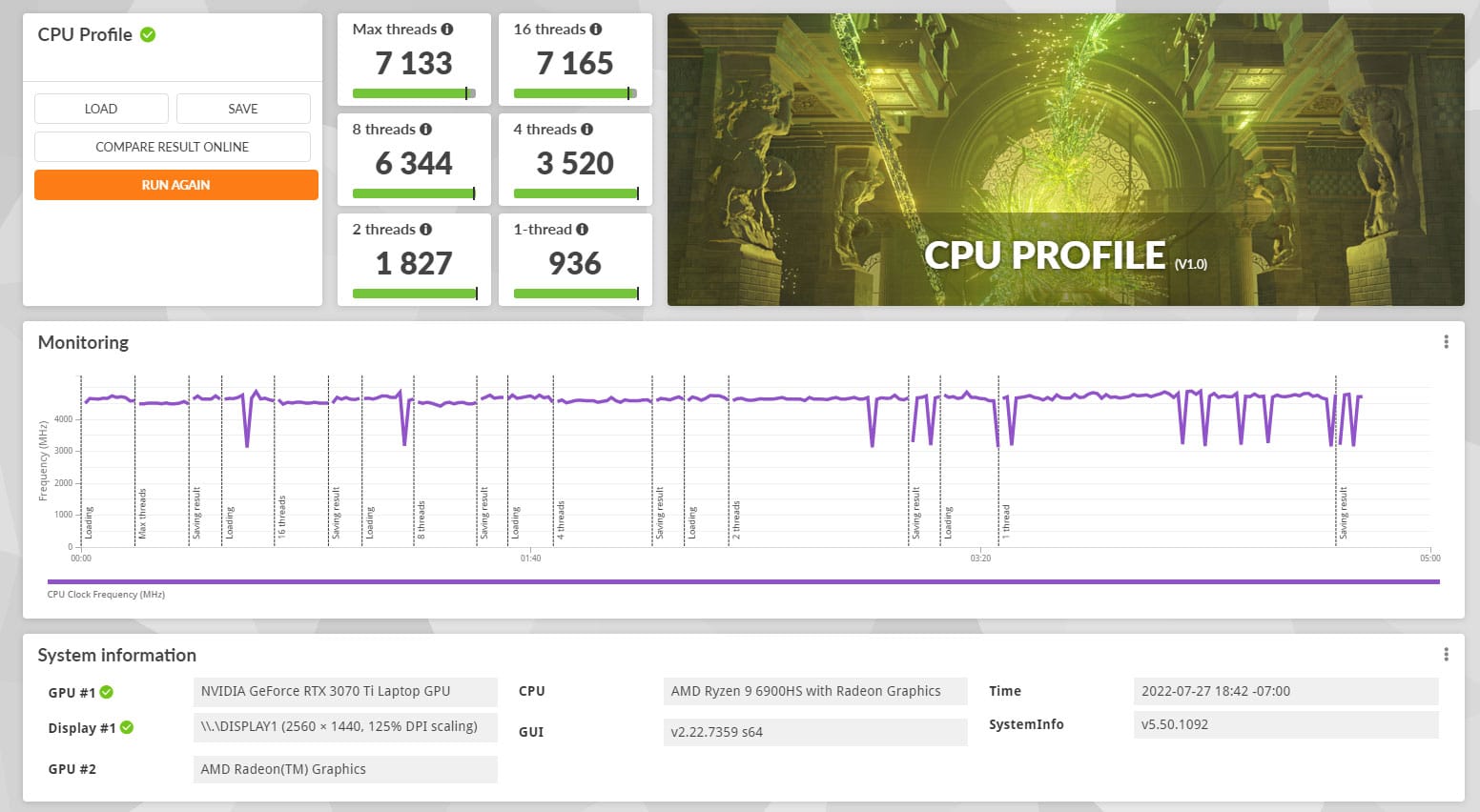
Finally, we ran our combined CPU+GPU stress tests on this notebook. 3DMark stress runs the same test for 20 times in a loop and looks for performance variation and degradation over time, and this unit barely failed it, which means there’s a slight degree of performance throttling with longer-duration sustained loads, as the components heat up over time. We’ll go over that further down.
Next, we ran the entire suite of tests and benchmarks, on the stock Turbo profile in Armoury Crate, the MUX set on Hybrid mode, and on FHD screen resolution for consistency with our other tests.
Keep in mind these are on the G15 running with 32 GB of RAM, in a 16GB onboard + 16 GB DIMM configuration.
- 3DMark – Fire Strike: 24596 (Graphics – 27374, Physics – 26916, Combined – 13013);
- 3DMark – Port Royal: 6714;
- 3DMark – Time Spy: 10698 (Graphics – 10698, CPU – 10704);
- Uniengine Superposition – 1080p Extreme: 7017;
- Uniengine Superposition – 1080p Medium: 18982;
- Handbrake 1.3.3 (4K to 1080p encode): 53.61 average fps;
- PassMark 10: Rating: 7843 (CPU: 25051, 3D Graphics: 22409, Memory: 2896, Disk Mark: 22243;
- PCMark 10: 7283 (Essentials – 10396, Productivity – 9306, Digital Content Creation – 10836);
- GeekBench 5.4.3 64-bit: Single-Core: 1606, Multi-core: 10228;
- CineBench R15 (best run): CPU 2307 cb, CPU Single Core 248 cb;
- CineBench R20 (best run): CPU 5517 cb, CPU Single Core 599 cb;
- CineBench R23: CPU 14158 cb (best single run), CPU 13943 cb (10 min run), CPU Single Core 1509 cb;
- x265 HD Benchmark 64-bit: 25.83 s.
And here are some benchmark results with only 16GB of soldered RAM:
- 3DMark – Fire Strike: 23826 (Graphics – 27171, Physics – 24612, Combined – 12088);
- 3DMark – Time Spy: 10445 (Graphics – 10724, CPU – 9105);
- Uniengine Superposition – 1080p Extreme: 6976;
- Handbrake 1.3.3 (4K to 1080p encode): 40.57 average fps;
- PassMark 10: Rating: 5298 (CPU: 24189 3D Graphics: 18252, Memory: 2724, Disk Mark: 14634);
- GeekBench 5.4.3 64-bit: Single-Core: 1575, Multi-core: 8148;
- CineBench R15 (best run): CPU 2297 cb, CPU Single Core 247 cb;
- CineBench R20 (best run): CPU 5386 cb, CPU Single Core 589 cb;
- CineBench R23: CPU 13561 cb (best single run), CPU 13442 cb (10 min run), CPU Single Core 1474 cb;
- x265 HD Benchmark 64-bit: 28.96 s.
For the most part, the results are similar between the two configurations. However, certain CPU-heavy loads benefit from the dual memory setup.
The differences are further showcased in the next batch of workstation benchmarks, on the same Turbo profile, where only some media-creation applications such as Adobe Photoshop/Premiere shows a decrease in performance with the onboard memory configuration, while most other tests return similar performance between the two:
- Blender 3.01 – BMW scene – CPU Compute: 2m 54s (Turbo);
- Blender 3.01 – BMW scene – GPU Compute: 22s (CUDA), 11.7s (Optix);
- Blender 3.01 – Classroom scene – CPU Compute: 6m 32s (Turbo, 32 GB dual-RAM), 6m 33s (Turbo, 16 GB soldered RAM);
- Blender 3.01 – Classroom scene – GPU Compute: 40s (CUDA), 23.4s (Optix);
- Pugetbench – DaVinci Resolve: 1077;
- Pugetbench – Adobe After Effects: -;
- Pugetbench – Adobe Photoshop: 1070 (Turbo, 32GB dual-RAM), 768 (Turbo, 16GB soldered RAM);
- Pugetbench – Adobe Premiere: 685 (Turbo, 32GB dual-RAM), 613 (Turbo, 16GB soldered RAM);
- SPECviewperf 2020 – 3DSMax: 102.01 (Turbo, 32GB dual-RAM), 99.70 (Turbo, 16GB soldered RAM);
- SPECviewperf 2020 – Catia: 64.56 (Turbo, 32GB dual-RAM), 61.27 (Turbo, 16GB soldered RAM);
- SPECviewperf 2020 – Creo: 89.27 (Turbo, 32GB dual-RAM), 84.50 (Turbo, 16GB soldered RAM);
- SPECviewperf 2020 – Energy: 24.55 (Turbo, 32GB dual-RAM), 24.40 (Turbo, 16GB soldered RAM);
- SPECviewperf 2020 – Maya: 338.25 (Turbo, 32GB dual-RAM), 335.48 (Turbo, 16GB soldered RAM);
- SPECviewperf 2020 – Medical: 34.20 (Turbo, 32GB dual-RAM), 34.08 (Turbo, 16GB soldered RAM);
- SPECviewperf 2020 – SNX: 19.83 (Turbo, 32GB dual-RAM), 19.30 (Turbo, 16GB soldered RAM);
- SPECviewperf 2020 – SW: 237.89 (Turbo, 32GB dual-RAM), 236.70 (Turbo, 16GB soldered RAM).
- V-Ray Benchmark: CPU – 10302 vsamples, GPU CUDA – 1259 vpaths, GPU RTX – 1581;
Based on these tests, you’ll want to populate the extra memory DIMM in your unit if you plan on editing media on this laptop, but for mostly everything else, the performance is not impacted by only running a 16 GB onboard configuration. However, having both memory slots populated does have an impact on the gaming experience as well, which we’ll touch on further down.
That aside, the Zephyrus G15 is an excellent performer for its class.
On the CPU side, it’s within 2-5% of the better AMD designs such as the ROG Zephyrus G14 and ROG Flow X16. Just keep in mind that those are capable of running quieter/cooler in sustained CPU loads.
At the same time, the Intel options are superior in IPC and single-core performance, and if provided with plenty of power, superior in multi-threaded capabilities as well. We’re looking at up to a 20% performance gain on something like an i9 Zephyrus M16, but less on lower-power i7 designs such as the Razer Blade 15 or the Lenovo Legion Slim 7i.
On the GPU side, this RTX 3070Ti 120W Zephyrus G15 implementation is on par with the similarly powered 3070Ti in the Zephyrus M16, and only a little under the ROG Flow X16 running at 125W. However, full-size laptops built on RTX 3070Ti 150W chips (such as the ROG Scar 15 or Scar 17) return as much as 10-12% higher scores in the GPU tests.
Overall, though, the Zephyrus G15 is an excellent performer given its thin-and-light design. It does run loud and rather hot, though, and we’ll discuss this in the gaming section below.
You can address the noise by opting for either the Performance or the Silent profiles.
Performance mode limits the fans to around 45 dBA at head-level and takes a slight toll on both the CPU and GPU performance. The internal temperatures remain very high on this mode, though. Here are some benchmark results on this Balanced mode:
- 3DMark – Fire Strike: 22946 (Graphics – 27508, Physics – 20525, Combined – 11103);
- 3DMark – Time Spy: 9680 (Graphics – 10206, CPU – 7493);
- Uniengine Superposition – 1080p Extreme: 6382;
- CineBench R20 (best run): CPU 4736 cb, CPU Single Core 594 cb.
Silent mode limits the fans at sub 35 dB fan levels, with cooler temperatures, but impacts the capabilities more significantly.
- 3DMark – Fire Strike: 13861 (Graphics – 13755, Physics – 18900, Combined – 10328);
- 3DMark – Time Spy: 5865 (Graphics – 5551, CPU – 8641);
- Uniengine Superposition – 1080p Extreme: 3789;
- CineBench R20 (best run): CPU 4672 cb, CPU Single Core 588 cb.
The CPU performance is still alright, at around 70-75% of Turbo mode, but the GPU is aggressively power-caped in this mode and performs at about 50% of what this configuration can do on Turbo.
Gaming performance
Let’s see how this 2022 ROG Zephyrus G15 notebook handles modern games.
We tested several games at QHD and FHD resolution on Ultra settings, on the stock Turbo and Performance profiles, with 32 dual slot or 16 GB onboard memory. I’ve also included hybrid by dGPU modes, in order for you the understand the benefit of having a MUX on this 2022 generation. We’ll also discuss Silent and Manual modes down below.
Here are the raw numbers.
AMD Ryzen 9 6900HS
+ RTX 3070Ti Laptop 100-120W
QHD Turbo,
32 GB dual RAM,
dGPU
QHD Turbo,
16 soldered RAM,
dGPU
QHD Turbo,
16 soldered RAM,
hybrid
FHD Turbo,
32 GB dual,
dGPU
FHD Performance,
32 GB dual,
dGPU
Battlefield V
(DX 12, Ultra Preset, RTX OFF)
127 fps (72 fps – 1% low)
116 fps (57 fps – 1% low)
–
150 fps (68 fps – 1% low)
141 fps (57 fps – 1% low)
Cyberpunk 2077
(DX 12, Ultra Preset, RTX OFF)
44 fps (36 fps – 1% low)
44 fps (38 fps – 1% low)
–
65 fps (54 fps – 1% low)
–
Doom Eternal
(Vulkan, Ultra Preset)
234 fps (163 fps – 1% low)
182 fps (122 fps – 1% low)
135 fps (88 fps – 1% low)
271 fps (173 fps – 1% low)
–
Far Cry 6
(DX 12, Ultra Preset, TAA)
80 fps (60 fps – 1% low)
74 fps (57 fps – 1% low)
69 fps (52 fps – 1% low)
87 fps (62 fps – 1% low)
–
Far Cry 5
(DX 11, Ultra Preset, SMAA)
103 fps (55 fps – 1% low)
101 fps (62 fps – 1% low)
93 fps (52 fps – 1% low)
115 fps (81 fps – 1% low)
–
Metro Exodus
(DX 12, Ultra Preset, RTX OFF)
64 fps (41 fps – 1% low)
64 fps (40 fps – 1% low)
62 fps (40 fps – 1% low)
79 fps (46 fps – 1% low)
–
Red Dead Redemption 2
(DX 12, Ultra Optimized, TAA)
84 fps (62 fps – 1% low)
79 fps (63 fps – 1% low)
76 fps (58 fps – 1% low)
107 fps (78 fps – 1% low)
–
Shadow of Tomb Raider
(DX 12, Highest Preset, TAA)
96 fps (62 fps – 1% low)
90 fps (60 fps – 1% low)
84 fps (56 fps – 1% low)
117 fps (66 fps – 1% low)
111 fps (62 fps – 1% low)
The Witcher 3: Wild Hunt
(DX 11, Ultra Preset, Hairworks On 4)
103 fps (83 fps – 1% low)
101 fps (76 fps – 1% low)
95 fps (66 fps – 1% low)
138 fps (88 fps – 1% low)
129 fps (90 fps – 1% low)
- Battlefield V, Cyberpunk, Doom, Witcher 3 – recorded with Fraps/in-game FPS counter in campaign mode;
- Far Cry 5, 6, Metro, Red Dead Redemption 2, Tomb Raider games – recorded with the included Benchmark utilities;
- Red Dead Redemption 2 Optimized profile based on these settings.
Those above are rasterization tests, and here are some results for RTX titles with and without DLSS.
AMD Ryzen 9 6900HS
+ RTX 3070Ti Laptop 100-120W
QHD Turbo,
32 GB dual RAM,
dGPU
FHD Turbo.
32 GB dual RAM,
dGPU
Battlefield V (DX 12, Ultra Preset, RTX ON, DLSS OFF)
76 fps (54 fps – 1% low)
104 fps (72 fps – 1% low)
Battlefield V (DX 12, Ultra Preset, RTX ON, DLSS ON)
–
–
Cyberpunk 2077 (DX 12, Ultra Preset + RTX, DLSS Balanced)
47 fps (38 fps – 1% low)
68 fps (54 fps – 1% low)
Doom Eternal (DX 12, Ultra Preset, RTX ON, DLSS Quality)
143 fps (106 fps – 1% low)
180 fps (142 fps – 1% low)
Far Cry 6 (DX 12, Ultra Preset + DXR reflections / shadows)
65 fps (52 fps – 1% low)
71 fps (55 fps – 1% low)
Shadow of Tomb Raider (DX 12, Highest Preset, TAA, RTX Ultra)
58 fps (37 fps – 1% low)
80 fps (42 fps – 1% low)
This Ryzen 9 + RTX 3070Ti configuration can handle most of the modern games at QHD resolution and Ultra settings, with or without RT. Something like the peculiar Cyberpunk is still a tougher nut to crack at Ultra details, but everything else runs fine.
The gaming performance is on par with other AMD based-configuration tested in the past, as well as with the Intel-based Zephyrus M16.
The higher-power Scar 15, which is one of the most powerful 3070Ti laptops available at this point, returns within 2-7% higher framerates in the tested games, at QHD resolution, and up to 10% higher at FHD resolution. That’s not much of a difference.
For what is worth, I must also mention that this 3070Ti Zephyrus G15 with a MUX outmatches the RTX 3080 configuration of the 2021 Zephyrus G15 in regular games, by as much as 25% at QHD resolution. Only once you you switch RT on, the two get closer in performance, thanks to the extra RT cores on the 3080 dGPU, but for regular gaming, the 3070Ti is a significantly faster performer.
At the same time, the results above showcase that you’ll want to switch this laptop on the dGPU – Ultimate MUX mode in Armoury Crate, as well as populate both memory slots inside, in order to get the best possible gaming performance. Gaming on the 16GB onboard configuration impacts the performance to a greater or lesser extent between titles – the more recent and more demanding the title, the smaller the impact. On the other hand, if you’re running high fps competitive games, the impact is more significant.
With these out of the way, let’s go over some performance and temperature logs, which are going to better explain some of our findings above.
On Turbo, the design allows for up to 140W of combined CPU+GPU power in games and demanding loads. The GPU takes up to 120W with Dynamic Boost, and the reminding 20W go to the CPU.
With the laptop sitting on the desk and in the games that scale well with Dynamic Boost, we’re looking at temperatures in the 80-88 C on the CPU side and 82-87 on the GPU side. The GPU performance decreases by a minor extent as the heat builds-up in those titles that allow for the GPU power to run at around 120W. The fans ramp up to about 51-52 dBA at head-level on this Turbo mode.
Some older titles such as Far Cry 5 or Battlefield V (or other older CPU-heavy ones) might not scale properly with Dynamic Boost, especially at lower resolutions. When that happens, the CPU can go over 90 degrees Celsius, while the GPU drops to around 80 C as it only runs at 100-110W.
The cooling design on G15 draws fresh air from the underside, and the bottom raises up thanks to the Ergolift hinges in order to favor the airflow underneath the chassis. As a result, the intakes aren’t choked with the laptop sitting on the desk, so bumping the back of the laptop off the desk doesn’t have a significant impact on the internal or external temperatures. Nonetheless, you should consider gaming on a raiser or especially on an active cooling pad to help lower the thermals here.
With that out of the way, let’s explore the other available modes in Armoury Crate.
Manual mode allows setting the fans at 100% rpms in order to test the maximum cooling capabilities, but the fans are already running at almost their maximum rpms on Turbo, so there’s little you will gain by going with these Manual settings. Instead, the Manual mode allows for a few other tweaks, such as GPU overclocking options, creating quieter custom fan profiles, or the ability to set a maximum GPU temperature limit, with the system then able to adjust its behavior based on that cap. That means you can set an 80 degree GPU limit and the system will power down the GPU in order to stay within that threshold and not overheat.
With all these high-performance profiles out of the way, if you’re looking for quieter noise levels when running games without mingling with the manual settings, your options are either the Performance or the Silent default modes.
On Performance, the fans spin at around 45 dB on this Zephyrus G15, the GPU is limited to up to 100W of power with Dynamic Boost. As a result, the framerates take a 5-10% hit compared to the Turbo mode.
The internal temperatures jump up on this mode, though, with the CPU running in the 90s C and the GPU at the 87 C thermal cap. Hence, the Performance mode isn’t something I would recommend for long gaming sessions on this chassis.
The Silent mode can be an option to consider if you’re aiming for a sub-35 dB gaming experience with cooler internal temperatures in the 70s, but this profile greatly limits the GPU power. You’ll want to opt for FHD resolution in this case, and even trim down the details in the most recent titles.
Lastly, this laptop can also run games on battery power on the Performance profile. The GPU stabilizes at 55W in this mode, with 80W crossload power, which ensures 60++ fps in most games at FHD resolution and Ultra settings. Don’t expect more than one hour of gameplay at full details, or longer with a 30 fps cap and lower settings.
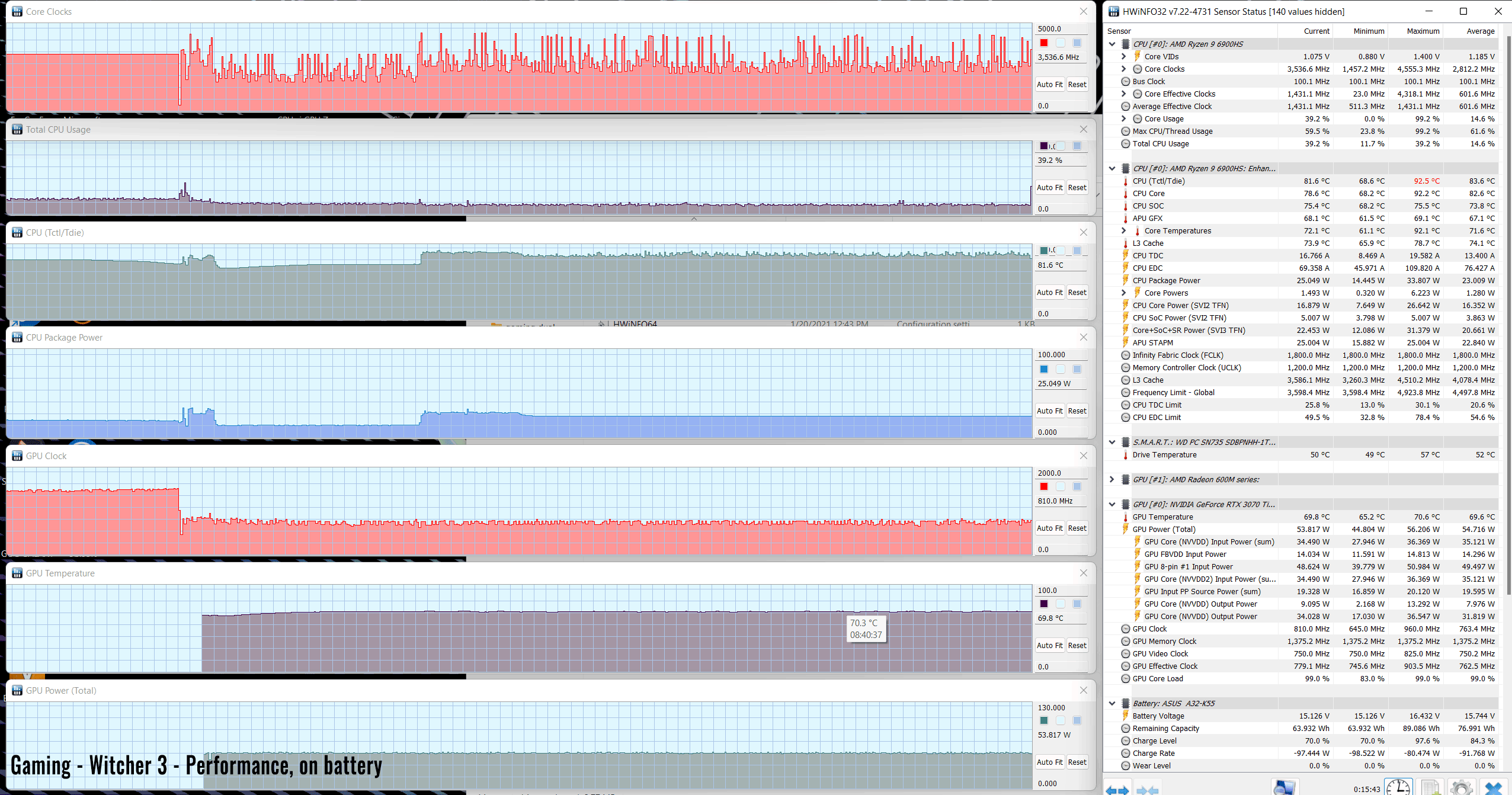
Noise, Heat, Connectivity, speakers, and others
The thermal module on the 2022 ROG Zephyrus G15 is pretty much identical to the one in the previous generation models, with the same fan/heatpipe/radiator design. The only change is in the array of foam used to channel the airflow over the cooling module and into the fans, as well as to prevent dust from getting over the motherboard and the components.
Here’s the 2022 cooling module.
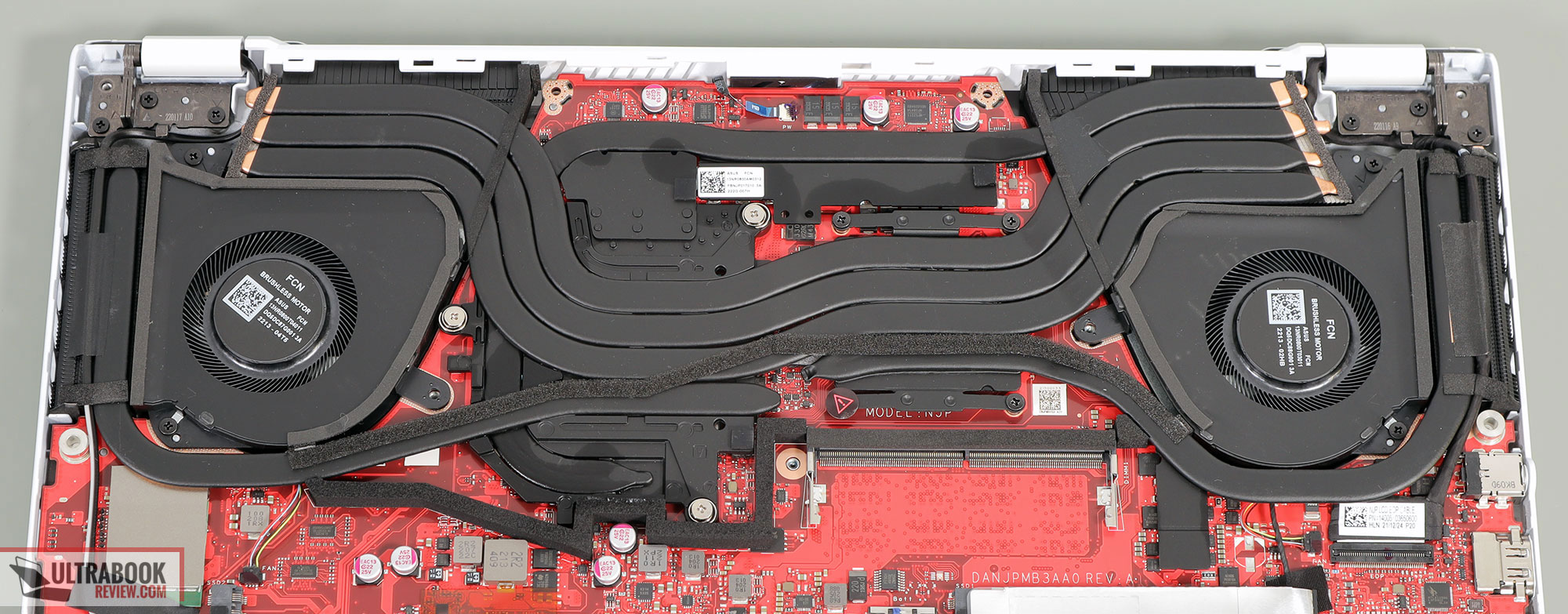
And here’s the 2021 module for comparison.
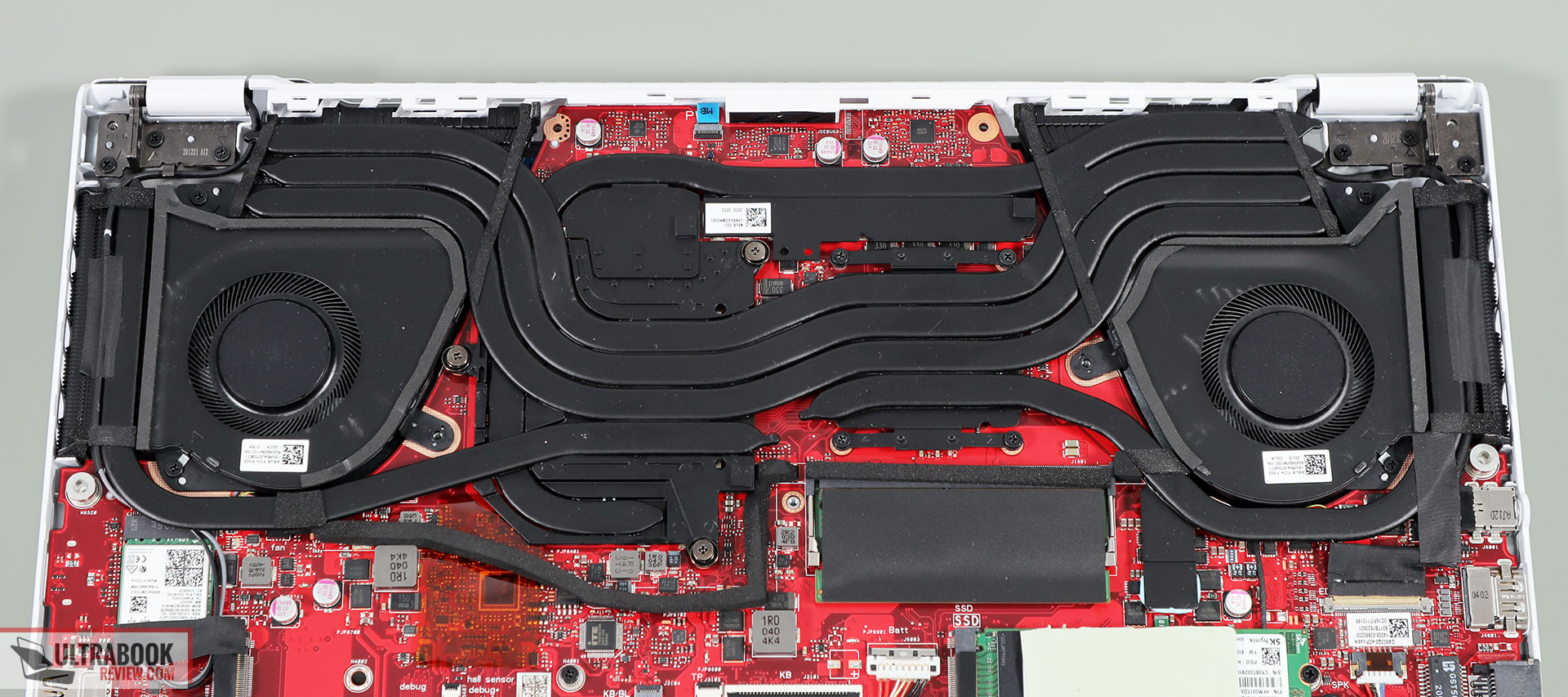
This thermal module does a fair job keeping handling the components inside this thin-and-light design. Both the CPU and the GPU run in the 80s in sustained loads, which are high temperatures, but understandable for this class.
However, that is only possible because the fans run louder on this laptop than on all the other portable designs we’ve tested, at 51-52 dB at head-level on Turbo. The Zephyrus M16 is the only one that comes close, but most others run at sub-50 dBA on their highest profiles, including the 2021 Zephyrus G15 models. Furthermore, the mid-level Performance/Balanced mode is pretty much unusable here, as the CPU/GPU run at dangerously high temperatures on this profile. Hence, the only way to game or run demanding applications at reduced noise is SIlent mode, with a significant tool in capabilities, or a custom-created Manual mode. Up to you if you’re willing to tweak this manually or not.
At the same time, the Zephyrus G15 runs quietly with daily multitasking and light use, on the Silent profile, with the fans running at almost inaudible levels of around sub 30 dBA levels. It’s not completely silent with multitasking, but the fans idle with video streaming and very basic use – that happens as long as the hardware runs at sub 60 degrees C, but multitasking can push the CPU above that, waking up the fans.
At the same time, the chassis runs warm, both with daily use and with demanding loads. With daily use, we’re looking at temperatures in the mid to high 30s around the keyboard, with the hottest part near the multimedia key at the top-left and around the FGV keys. The back goes above 40s in some spots. Overall, these are fine for casual use and even for lap use, but still higher than the norm in the class.
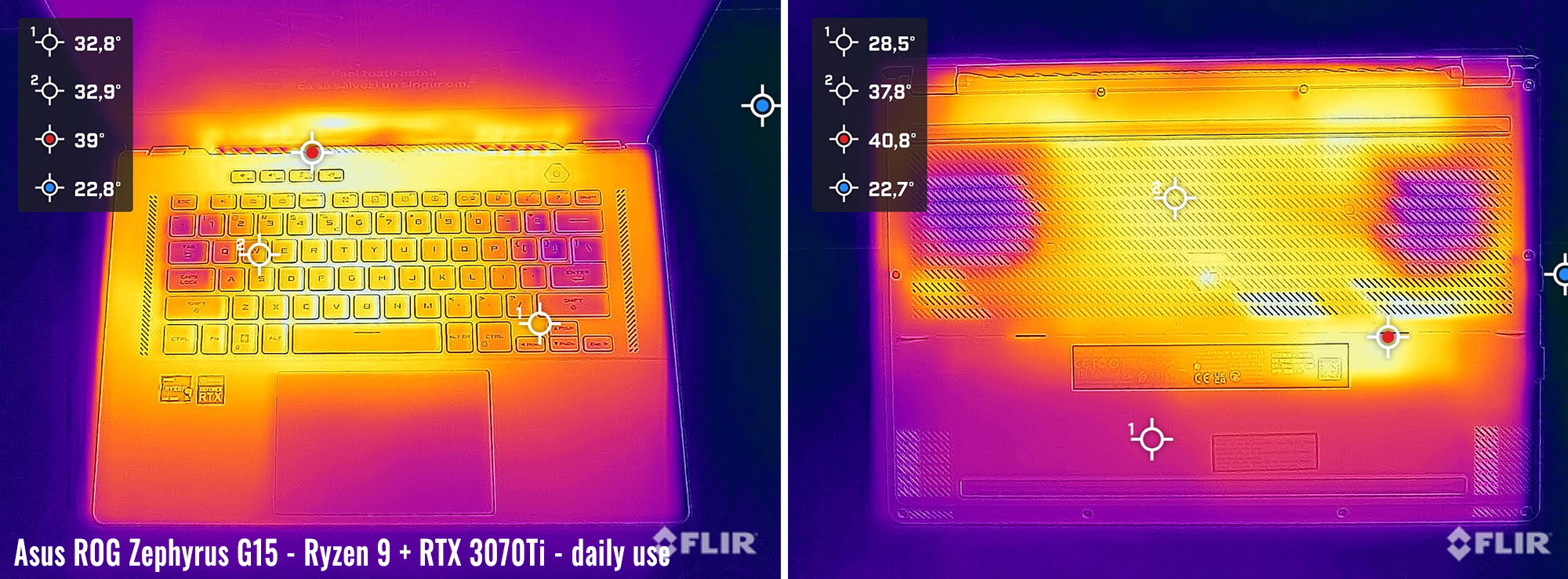
*Daily Use – streaming Netflix in EDGE for 30 minutes, Silent profile, fans at 0-30 dB
The exterior temperatures rise up with demanding loads and games. The keyboard area runs in the high 30s and 40s, which are perfectly fine, but the hottest spots around the radiators and on the back of the laptop go over 50s. The laptop runs hotter on Performance than on Turbo.
So while the areas that you’ll come in contact with do not overheat on this laptop, I would still recommend opting for a cooling pad or at least a raised with long gaming sessions, just to help out the cooling as much as possible and drive the internal/external temperatures down.
I’ll also add that this thermal design blows the hot air into the screen’s bezel, as mentioned in a previous section, and as a result, the bottom bezel is actually the hottest part on this laptop. Thankfully, the bezel is thick enough to absorb most of the outputted heat, so the panel only reaches temperatures in the low to mid-40s, which should be fine long-term. By increasing the fan speeds on Turbo mode, the bezel and the screen are not running as hot on this 2022 model as they were on the 2021 Zephyrus G15 we’ve tested in the past.


*Gaming – Performance – playing Cyberpunk 2077 for 30 minutes, fans at ~45 dB
*Gaming – Turbo, on desk – playing Cyberpunk 2077 for 30 minutes, fans at ~51-52 dB
For connectivity, there’s Wireless 6E and Bluetooth 5.2 through a Mediatek chip on this unit, the same offered on other AMD 6000 ROG laptops. It performed well on this unit, and I see no reason why I’d want to exchange that for something else. I’ve seen complaints about the chip showing a delay in reconnecting to WiFi once your wake up the laptop from sleep, but I haven’t experienced it on my sample, with the drivers available at the time of this review – Aug 2022.
The audio system includes 6 speakers on the Zephyrus G15, with two dual-force woofers on the bottom and 2 tweeters firing through the grills surrounding the keyboard. Both the quality and volumes are excellent here, with even some decent bass. This is surely one of the better audio systems you can find on any laptop these days. At least as long as you don’t run into QC effects, as some 2021 units have been reported to ship with blown-out speakers. Make sure to properly test yours.
One final aspect to mention here is the camera, which is finally available on the Zephyrus G15 series and placed at the top of the main display, where it should be, flanked by a set of microphones. The image quality isn’t much, as this is just an HD shooter. IR functionality is baked in, with support for Hello for quickly logging into Windows.
Battery life
There’s a 90Wh battery inside this ROG Zephyrus G15, just like on all other 2022 ROG Strix and Zephyrus models, which is excellently sized for a portable design.
The system automatically switches the screen’s refresh to 60 Hz when using the laptop on battery, to increase efficiency, which explains the quick screen flicker when you disconnect the laptop from the wall. If you’re looking to maximize runtimes, make sure you’re using the laptop with the MUX set in the Hybrid mode and not on discrete GPU – on the latest Armoury Crate version, that’s either the Standard or the Eco GPU mode.
Here’s what we got on our review unit in terms of battery life, with the screen’s brightness set at around 120 nits (~60 brightness) and on Standard mode.
- 18 W (~5+ h of use) – text editing in Google Drive, Silent Mode, screen at 60%, WiFi ON;
- 19 W (~5+ h of use) – 1080p fullscreen video on Youtube in Edge, Silent Mode, screen at 60%, WiFi ON;
- 18 W (~5+ h of use) – Netflix 4K fullscreen in Edge, Silent Mode, screen at 60%, WiFi ON;
- 23 W (~4-5 h of use) – browsing in Edge, Balanced Mode, screen at 60%, WiFi ON;
- 85 W (~1+ h of use) – Gaming – Witcher 3, Balanced Mode, screen at 60%, WiFi ON, no fps limit.
These runtimes are shorter than what I was expecting, especially with light use and video streaming. The 2021 Zephyrus G15, as well as all the other AMD Ryzen 6000 laptops tested recently, ran more efficiently, but some sort of driver issue is preventing this unit from lasting as long as it should. I looked into running the latest drivers and software from Asus’s website, but didn’t get the time to trouble check further.
The laptop ships with a 240W power brick, fairly compact for what it is. The battery fills up in 2+ hours, with fast charging for the first half an hour, and USB-C charging is supported, up to 100W.
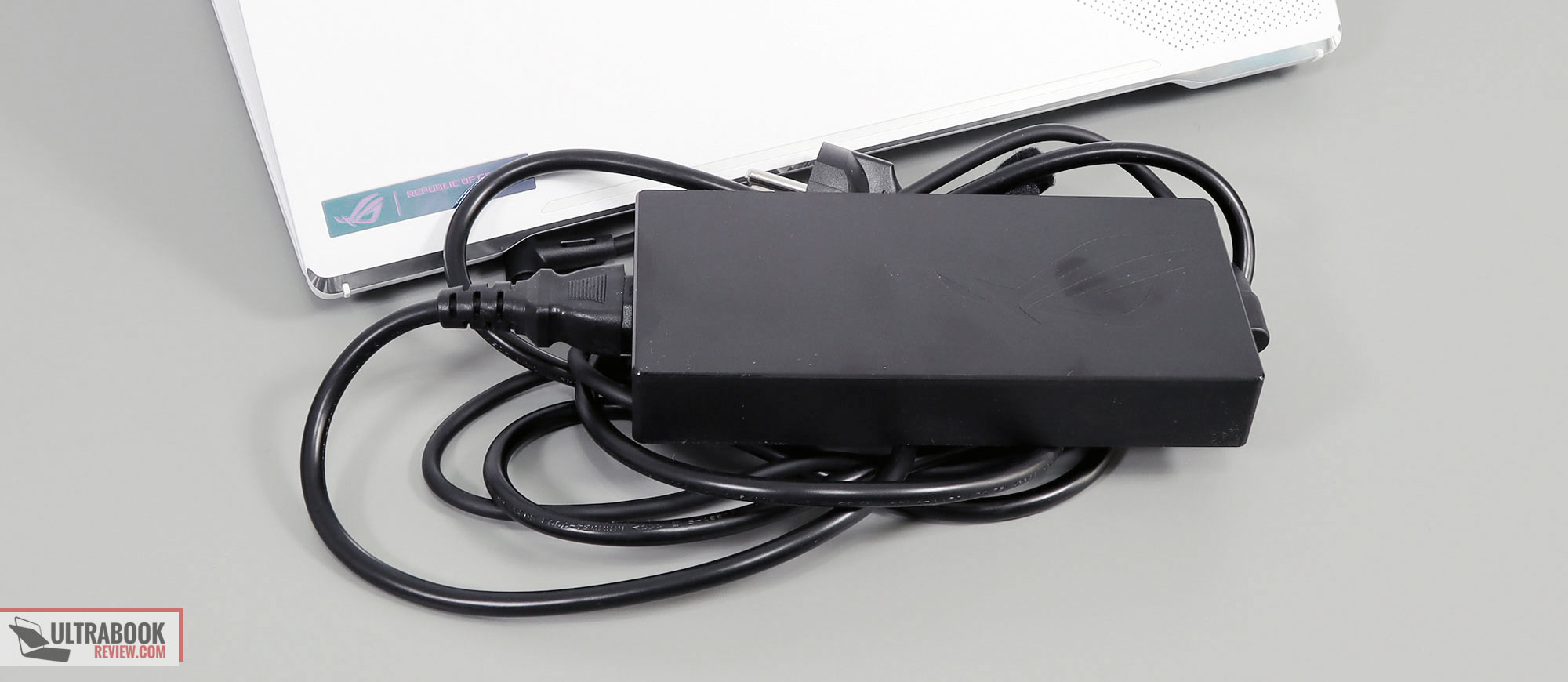
Price and availability- 2022 ASUS ROG Zephyrus G15
At the time of this article, the 2022 Asus ROG Zephyrus G15 is widely available in stores all around the world.
This RTX 3070Ti Zephyrus G15 GA503RW model reviewed here is listed in the US for $1999 and up, and is also available over here in Europe for between 1900 to 2100 EUR between the different countries.
The RTX 3060 Zephyrus G15 GA503RM version goes for around $1600 in the US, and as low as 1400 EUR here in Europe.
Both are among the most affordable models available in the performance thin-and-light space right now, more affordable than other Asus ROG laptops and the majority of other 2022 options from other brands.
Follow this link for updated configurations and prices in your region at the time you’re reading this article.
Final thoughts- Asus ROG Zephyrus G15 review
While at a first glance the 2022 Zephyrus G15 might seem like a minor update of the previous G15 models from 2021, in real-life this is now a better-balanced product than it used to be, and a much better-value buy in today’s environment.
To put it simply, this is one of the best-priced thin-and-light powerful laptops on the market right now. And while compact and lightweight, it offers 80-90% of the capabilities of a thicker full-size design. The trade-off is that all of these are possible with loud running fans, hot internals, and warm exterior temperatures. However, on Turbo mode, both the components and the chassis run within acceptable temperature thresholds, and I won’t worry about heat impacting this product over time.
In fact, compared to the previous Zephyrus G15 2021, the 2022 model runs louder, but cooler, and offers significant gains in performance, as this year’s RTX 3070Ti model with a MUX is noticeably faster in games and sustained loads than the RTX 3080 model from the past. On top of that, it’s more affordable than the 3080 used to be last year, which matters even more today, in mid-2022, where mostly everything else has gotten more expensive YoY.
Now, in all fairness, there are better thin-and-light laptops out there, with faster processors, better cooling, a superior IO design, and better displays. The ROG Flow X16 comes to mind, with its quite tri-fan cooling and miniLED display – but that’s hundreds of dollars more expensive.
So, if you’re on a tighter budget but still want a capable multi-purpose laptop with some excellent gaming abilities, the Zephyrus G15 should definitely be on your list this year. Just make sure you understand and accept the noise/thermals particularities, and the fact that you’d better keep this mostly indoors, otherwise that sub-350-nits display might not do for you.
That’s pretty much my review of the Asus ROG Zephyrus G15 GA503RW. Looking for your thoughts on the series in the comments section down below.

Disclaimer: Our content is reader-supported. If you buy through some of the links on our site, we may earn a commission.
Navigation: Ultrabookreview.com » Asus
Our content is reader-supported. If you buy through some of the links on our site, we may earn a commission. Terms


Review by: Andrei Girbea
Andrei Girbea, Editor-in-Chief. I’ve a Bachelor’s in Computer Engineering and I’ve been covering mobile technology since the 2000s. You’ll mostly find reviews and thorough guides written by me here on the site, as well as some occasional first-impression articles.
. I’ve a Bachelor’s in Computer Engineering and I’ve been covering mobile technology since the 2000s. You’ll mostly find reviews and thorough guides written by me here on the site, as well as some occasional first-impression articles.






